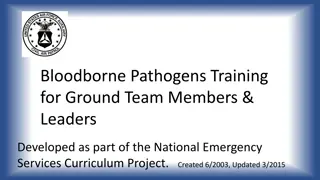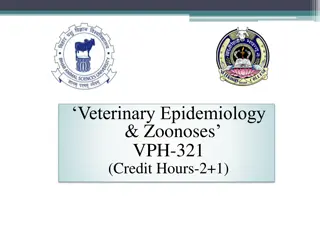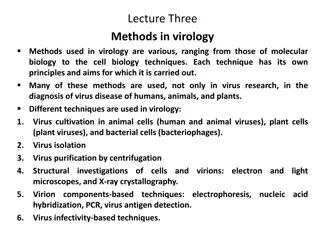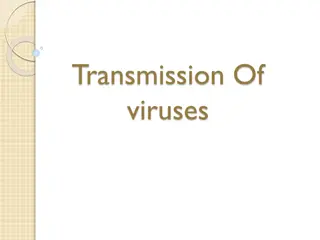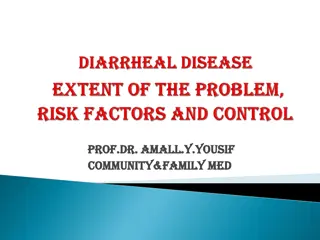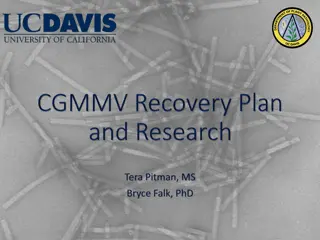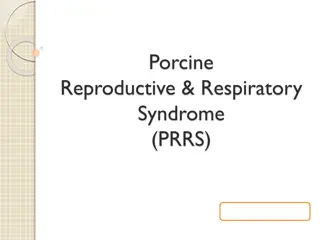Maedi-Visna Virus: Impacts, Transmission & Control
Maedi-Visna and Caprine Arthritis and Encephalitis are economically important viral diseases affecting sheep and goats. Learn about their etiology, species affected, geographic distribution, transmission methods, disinfection, diagnostic tests, treatment options, control measures, clinical signs, and post-mortem lesions. Explore the significance of these diseases and potential economic losses associated with them.
Download Presentation

Please find below an Image/Link to download the presentation.
The content on the website is provided AS IS for your information and personal use only. It may not be sold, licensed, or shared on other websites without obtaining consent from the author.If you encounter any issues during the download, it is possible that the publisher has removed the file from their server.
You are allowed to download the files provided on this website for personal or commercial use, subject to the condition that they are used lawfully. All files are the property of their respective owners.
The content on the website is provided AS IS for your information and personal use only. It may not be sold, licensed, or shared on other websites without obtaining consent from the author.
E N D
Presentation Transcript
INDEX INDEX 1. 2. 3. 4. 5. 6. Importance Etiology Species affected Geographic distribution Transmission Disinfection 7. 8. 9. 10. Diagnostic tests 11. Treatment 12. Control 13. Bibliography Incubation period Clinical signs Post Mortem Lesions
IMPORTANCE IMPORTANCE Maedi-visna and caprine arthritis and encephalitis are economically important viral diseases that affect sheep and goats. however, some animals develop one of several progressive, untreatable disease syndromes. Additional economic losses may occur due to marketing and export restrictions, premature culling and/or poor milk production. Economic losses can vary considerably between flocks.
ETIOLOGY ETIOLOGY Small ruminant lentiviruses (SRLVs) belong to the genus Lentivirus in the family Retroviridae (subfamily Orthoretrovirinae). Two of these viruses have been known for many years: maedi-visna virus (MVV), which mainly causes the diseases maedi and visna in sheep, and caprine arthritis encephalitis virus (CAEV), which primarily causes arthritis and encephalitis in goats.
SPECIES AFFECTED SPECIES AFFECTED SRLVs cause disease in sheep and goats. Classical strains of MVV mainly occur in sheep, but some other genotype A variants infect both species. Genotype C viruses also affect both sheep and goats, while classical CAEV isolates (genotype B), and genotypes D and E mainly occur in goats. The host specificity of SRLVs is not absolute: viruses transmitted from sheep to goats (or vice versa) sometimes adapt to and persist in the new species. ZOONOTIC POTENCIAL: there is no evidence that humans are susceptible to any SRLVs.
GEOGRAPHIC DISTRIBUTION GEOGRAPHIC DISTRIBUTION SRLV genotypes A and B, which contain the classical MVV and CAEV isolates, respectively, are widely distributed. MVV has been found in most sheep-raising countries other than Iceland, where it was introduced but eradicated, and Australia and New Zealand. CAEV has been detected in most industrialized countries. Genotypes C (Norway), D (Spain and Switzerland) and E (Italy) appear to be limited to small geographic areas in Europe, at present.
TRANSMISSION TRANSMISSION MVV and CAEV can be transmitted to lambs, kids or other susceptible species in milk or colostrum. Lactogenic transmission was once thought to be the major route by which SRLVs spread. SRLVs have been found in respiratory secretions and feces, and infections have been demonstrated by intranasal or intraconjunctival inoculation, and via fecally-contaminated water.
TRANSMISSION TRANSMISSION SRLVs can be found in semen and the female reproductive tract (e.g., uterus) of both sheep and goats, but they do not appear to directly infect oocytes or sperm. Sexual transmission is at least theoretically posible.
DISINFECTION DISINFECTION Lentiviruses can be destroyed with most common disinfectants including lipid solvents, periodate, phenolic disinfectants, formaldehyde and low pH (pH < 4.2). Phenolic or quaternary ammonium compounds have been recommended for the disinfection of equipment shared between seropositive and seronegative herds.
INCUBATION PERIOD INCUBATION PERIOD The incubation period for SRLV-associated diseases is highly variable, and usually lasts for months to years. Sheep typically develop the clinical signs of maedi when they are at least 3-4 years of age. Visna seems to appear somewhat sooner, with clinical signs in some sheep as young as 2 years. CAEV-associated encephalitis usually occurs in kids 2 to 6 months of age, although it has also been reported in younger and older animals.
CLINICAL SIGNS CLINICAL SIGNS MAEDI IN SHEEP: progressive dyspnea, fever, bronchial exudates and depression are not usually seen. Genotype C viruses can also cause lung lesions (chronic interstitial pneumonia) in sheep. VISNA IN SHEEP: ataxia, incoordination, muscle tremors, paresis and paraplegia, usually more prominent in the hindlegs. Other neurological signs, including rare instance of blindness, may also be seen. ARTHRITIS IN SHEEP: One genotype B virus (CAEV) caused an outbreak characterized by enlargement almost exclusively of the carpal joint. Pain and lameness occurred in a minority of the affected sheep.
CLINICAL SIGNS CLINICAL SIGNS ENCEPHALOMYELITIS IN GOATS. POLYARTHRITIS IN GOATS. DYSPNEA IN GOAT. MASTITIS IN SHEEO AND GOATS. OTHER EFFECTS IN SHEEP AND GOATS: Some studies, but not others, have reported decreased fertility in SRLV-infected animals and lower birth weights in their offspring. Weight gain may be decreased in young animals, possibly due to lower milk yields from dams with indurative mastitis. INFECTIONS IN WILD OR CAPTIVE WILD SPECIES: Captive Rocky Mountain goats infected with CAEV developed signs of chronic pneumonia and wasting, with neurological signs and /or joint lesions in some animals.
POST MORTEM LESIONS POST MORTEM LESIONS MAEDI: In sheep with maedi, the lungs are enlarged, abnormally firm and heavy, and fail to collapse when the thoracic cavity is opened. Nodules may be found around the smaller airways and blood vessels, and the mediastinal and tracheobronchial lymph nodes are usually enlarged and edematous. Description: Sheep, lung. Lung fails to deflate and contains coalescing multifocal gray-white nodules/plaques (proliferative lymphocytes and adjacent atelectatic depressed parenchyma (red-pink). pneumocytes) with
POST MORTEM LESIONS POST MORTEM LESIONS NEUROLOGICAL FORMS: Apart from wasting of the carcass, the gross lesions of visna or the encephalitic form of caprine arthritis and encephalitis are usually limited to the brain and spinal cord. The meninges may be cloudy and the spinal cord may be swollen. MASTITIS: In animals with indurative mastitis, the udder is diffusely indurated and the associated lymph nodes may be enlarged.
POST MORTEM LESIONS POST MORTEM LESIONS ARTHRITIS: The lesions mainly affect the carpal joints, and to a lesser extent the tarsal joints. The joint tendon sheaths bursae may be calcified. capsules, and Description: Sheep, lung. Lung fails to deflate with pale gray proliferative cranioventral (reddish rea). coalescing areas atelectasis and
MICROSCOPICAL LESIONS
DIAGNOSTIC TESTS DIAGNOSTIC TESTS Diseases caused by SRLVs can be diagnosed by both virological and serological methods. Antibodies to SRLVs are usually diagnosed by various enzyme-linked immunosorbent assays (ELISAs) or agar gel immunodiffusion (AGID) tests, using either serum samples or milk. Polymerase chain reaction (PCR) assays or virus isolation can also be used for diagnosis. These tests may be particularly useful before the animal seroconverts.
DIAGNOSIS TESTS DIAGNOSIS TESTS At necropsy, SRLVs can be found in affected tissues, such as lung, mediastinal lymph node and spleen (maedi); brain and spinal cord (visna); choroid plexus, udder or synovial membrane. Histology of affected tissues, using biopsy or necropsy samples, can help confirm the diagnosis in symptomatic animals.
TREATMENT TREATMENT There is no specific treatment for diseases caused by SRLVs. Supportive therapy may be helpful in individual animals, but it cannot stop the progression of disease. Antibiotics may be used for secondary bacterial infections in cases of mastitis or pneumonitis. High-quality, readily digestible feed may delay wasting.
CONTROL CONTROL DISEASE REPORTING: Veterinarians who encounter or suspect a reportable disease should follow their national and/or local guidelines for informing the proper authorities. PREVENTION: Uninfected herds should also be kept from contact with untested or seropositive herds. Mixing sheep and goats, or feeding milk or colostrum from one species to another, can lead to the transfer of viruses between species. There are currently no vaccines for SRLVs. The discovery of genes associated with increased susceptibility to SRLVs may make it possible to produce disease-resistant flocks by selective breeding.
BIBLIOGRAPHY BIBLIOGRAPHY The Merck Veterinary Manual http://www.merckmanuals.com/ World Organization for Animal Health (OIE) http://www.oie.int OIE Manual of Diagnostic Tests and Vaccines for Terrestrial Animals http://www.oie.int/international-standard-setting/terrestrial- manual/access-online/ OIE Terrestrial Animal Health Code http://www.oie.int/international-standard-setting/terrestrial- code/access-online/







